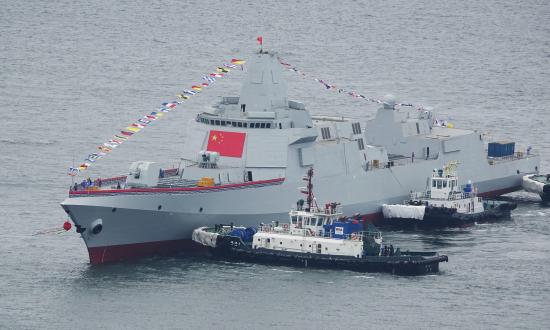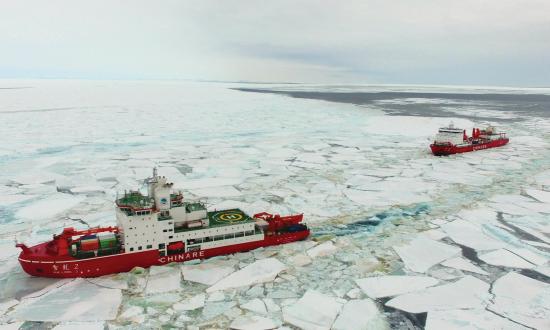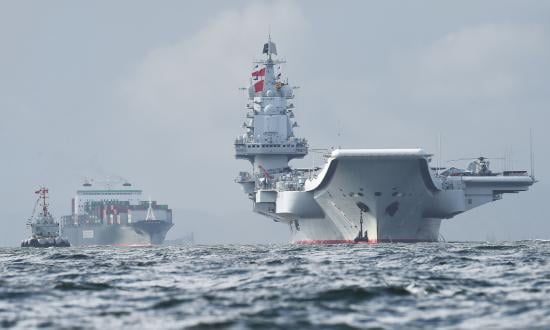In a 1988 newspaper article, “Why Moscow Is No Match for America’s Military,” author Tom Clancy wrote that a military designed in isolation is irrelevant. Military forces must be designed around their mission—and that mission must relate to the capabilities and ambitions of their adversaries. Thus, according to Clancy, the Soviet Union’s preponderance of ships and tanks was less a predictor of battlefield success than of its gross deficiencies in doctrine, training, and force design.1 Soviet fleets were built to exist, while U.S. fleets were built to defeat Soviet fleets.
The U.S. Marine Corps also must be designed according to the fight it is most likely to encounter. However, the imperative to focus on the Indo-Pacific has confused the effort to align Marine Corps doctrine to the challenges of great power competition. In Force Design 2030 and Littoral Operations in a Contested Environment (LOCE), the Marine Corps seeks to mirror the 2018 National Defense Strategy (NDS) by pivoting away from the global war on terrorism and refocusing on the challenges of great power competition. However, a critical fault in Force Design 2030 and LOCE is the assumption that increased integration between the Marine Corps and Navy will necessarily result in joint battlespaces. They assume that great power conflicts will not be irregular, and that near-peer adversaries primarily will fight at the high end of the conflict spectrum.
On the contrary, the pattern of Chinese and Russian expansion in African and Indian Ocean littorals makes it more likely that future Marines will engage Indo-Pacific rivals—and their proxies—in places such as the Horn of Africa long before they fight on a western Pacific island. The Marine Corps must maximize its ability to wage irregular expeditionary war against near-peer adversaries, rather than wedging itself into an ill-suited Indo-Pacific doctrine.
Expeditionary Force in the Era of Great Power Competition
Marine Corps Commandant General David H. Berger begins Force Design 2030 by noting that the NDS “redirected the Marine Corps’ mission focus from countering violent extremists in the Middle East to great power/peer-level competition, with special emphasis on the Indo-Pacific.”2 General Berger’s assessment of the NDS is sound, but the Marine Corps should emphasize threats originating in the Indo-Pacific. While China does pose a threat to U.S. interests in the Indo-Pacific theater, the expeditionary threat of Chinese and Russian expansionism calls for a near-peer “9-1-1” response capability, for which the Marines are uniquely suited.
Indo-Pacific conflict is not expeditionary for China or Russia to the extent that it is for U.S. forces, which makes it a poor strategic match for the Marine Corps. China’s homeland defense strategy is based on defensive missile saturation from its coasts and near islands that makes combat near the mainland extremely unpalatable—and that is precisely the point.3 China’s ambitions abroad, however, are less static, more aggressively evolutionary, and very expeditionary in nature—especially in Africa.
The People’s Liberation Army-Navy Marine Corps (PLANMC) is China’s fastest growing armed force, and it is designed to protect Chinese interests abroad while leveraging agility against potential great power competitors—such as the U.S. Marine Corps. While China’s Indo-Pacific home army is shrinking by 300,000 soldiers, the PLANMC is quintupling from 20,000 to 100,000 marines. This increase is concurrent with China’s expansion of military facilities in Gwadar, Pakistan, and Djibouti, in the Horn of Africa, which positions Chinese expeditionary capability close to the Strait Hormuz and abreast Bab-el-Mandeb Strait—neither of which is in the Indo-Pacific.4
Sino-Africa: A Complex Security Environment
While the NDS outlines the pivot toward great power competition, it is critical not to underestimate the spectrum of conflict that U.S. forces will encounter. Just as the United States faced Soviet-fueled proxy conflicts in Korea, Vietnam, and elsewhere during the Cold War, the Marine Corps must prepare for proxy engagements on an African continent awash with Chinese and Russian militarism. The NDS notes that great power competition will bring about “the reemergence of long-term strategic competition, rapid dispersion of technologies, and new concepts of warfare and competition that span the entire spectrum of conflict.”5 This suggests that, as in the Cold War, the high-end equipment and capabilities of near-peer adversaries may be arrayed against U.S. forces in places where interests clash.
If presence denotes importance, Africa is the continent to watch.
Over the past five years, China has dramatically increased its military footprint in Africa and within the militaries of African nations. In 2017, China established its first extraterritorial military base in the tiny African country of Djibouti, only a few miles from the only enduring U.S. military installation on the continent—Camp Lemonnier. Both bases are adjacent to the strategically critical Bab-el-Mandeb Strait.6
In 2015, Chinese President Xi Jinping pledged “$100 million of free military assistance to the African Union in the next five years to support the establishment of the African Standby Force and the African Capacity for Immediate Response to Crisis.”7 Under the “China-Africa Action Plan,” China funds professional military education for tens of thousands of African military officers by hosting them at Nanjing Military Academy, Dalian Naval Academy, and the PLA Air Force Aviation University. Higher ranking African military leaders are able to attend Chinese command and staff colleges such as China’s Defense University and National University of Defense Technology. In some cases, Chinese drill instructors have been sent to train African troops directly. Other African nations have even built military schools based on the Chinese model, reflecting the ideological spread for which China has been aiming.8
These military partnerships are buttressed by billions of dollars in infrastructure loans to African countries—part of China’s Belt and Road Initiative to tether African nations to China through both debt and the subsequent business engagement of Chinese firms that receive African infrastructure contracts. More than 10,000 Chinese-owned firms currently operate throughout the continent, employing millions of African workers.9
Russia, while not as well-resourced as China, has accelerated its African engagement at an even more aggressive pace. Since 2015, Russia has signed security cooperation agreements with 21 African nations. In 2020, Russia began the process of securing basing agreements with Egypt, the Central African Republic, Eritrea, Madagascar, Mozambique, and Sudan. Like China, Russia is sending military officers and private military companies—such as the Wagner Group—to train African troops, while inviting African military officers to train in Russia.10 This politico-military engagement creates not only doctrinal links between African and Russian militaries, but also economic ties. Russia is now the top weapons supplier in Africa, with a market share of 37.6 percent (compared with 16 percent for the United States, 14 percent for France, and 9 percent for China).11
Dramatic increases in cooperation between African nations and U.S. adversaries must not be considered in isolation. The result is that powerful adversaries are deeply embedded in littoral and continental battlespaces of great strategic consequence. If the time ever comes when U.S. access to vital straits, ports, or allies is compromised, the United States needs an expeditionary force in readiness that can meet near-peer adversaries in an irregular environment. Marine Corps doctrine must meet that moment.
Pointing the Spear in the Right Direction
None of the aforementioned is meant to suggest that great power competition threats in the Indo-Pacific are not real or pressing. They are both, and the Marine Corps would surely play some role in any great power conflict there. But the Marine Corps is more likely to face these adversaries far afield from the Indo-Pacific.
Paired with the right doctrine, many of the force design changes that General Berger outlines in Force Design 2030 are correct for a future Marine Corps that needs to be lighter (divesting most tanks and armor), more agile (investing in reconnaissance units and rocket artillery batteries), and more resilient.12 Capacity-enhancing concepts such as expeditionary advanced base operations (EABO) are perfectly suited for the relatively predictable expeditionary hot spots that likely will define great power conflict in African and Indian Ocean littorals. EABO supports the Navy’s distributed lethality effort by providing highly mobile land-based sensors and shooters that work in tandem with Navy assets offshore—a valuable force multiplier against expeditionary threats in the Gulf of Aden, the Red Sea, or the Mozambique Channel.13 But these same capabilities are ill-suited for small islands in the South China Sea, where Chinese military planners have invested decades in creating bespoke killing fields. High-end hypervelocity conflict against a great power in the western Pacific would render any sort of island-hopping campaign either a moot point or a bloodbath.
Within the key insights of Force Design 2030’s wargaming analysis is the sobering and open-ended requirement to “prevent fait accompli scenarios.”14 This is because most Indo-Pacific wargame scenarios are over before they truly begin. The Center for Strategic and International Studies has noted that most great power conflict scenarios in the western Pacific result in underreaction (and fait accompli victory for China) or rapid escalation and overreaction that results in highly costly and massively kinetic conflict—at best a Pyrrhic victory.15 This polarity of outcomes dramatically narrows the range of strategic effects that the Marine Corps—a highly precise, expeditionary fighting force—could accomplish. Fighting China in the Indo-Pacific is the Marine Corps’ Kobayashi Maru—a no-win scenario.16
The Marine Corps has a critical role in the era of great power competition and likely will be the first to fight. A leaner, more expeditionary Corps will be able to reach targets and direct fire faster than ever before, but Navy and Marine Corps planners need to point the spear in the right direction.
Look to Africa.
1. Tom Clancy, “Why Moscow Is No Match for America’s Military,” Washington Post, 24 January 1988.
2. GEN David Berger, USMC, Force Design 2030 (Washington, DC: Headquarters Marine Corps, 2002), 2.
3. Innovations in directed-energy countermeasures and kinetic interceptors may tip the scales considerably for the U.S. Navy, but these technologies are still unproven in the field. Moreover, any measure-vs-countermeasure great power conflict scenario generally favors the homeland defender over an attacking expeditionary force.
4. Minnie Chan, “As Overseas Ambitions Expand, China Plans 400 Percent Increase to Marine Corps Numbers, Sources Say,” South China Morning Post, 13 March 2017.
5. GEN James Mattis, USMC (Ret.), “Summary of the 2018 National Defense Strategy, U.S. Department of Defense” (2018), 1.
6. Andrew Jacobs and Jane Perlez, “U.S. Wary of Its New Neighbor in Djibouti: A Chinese Naval Base,” The New York Times, 25 February 2017.
7. Lina Benabdallah, “China-Africa Military Ties Have Deepened. Here are 4 Things to Know,” Washington Post, 6 July 2018.
8. Paul Nantulya, “China Promotes Its Party-Army Model in Africa,” Africa Center for Strategic Studies, 28 July 2020; Sarah Zheng, “Rwandan Troops Trained by Chinese Military Mark 25th Anniversary of Liberation,” South China Morning Post, 7 July 2019.
9. Kartik Jayaram, Omid Kassiri, and Irene Yuan Sun, “The Closest Look Yet at Chinese Economic Engagement In Africa,” McKinsey & Company, 28 June 2017.
10. Peter Suciu, “Russian Military Looks to Establish Six Military Bases in Africa,” The National Interest, 11 August 2020.
11. Anadolu Agency, “Russia to Build Military Bases in 6 African Countries: Report,” Daily Sabah, 4 August 2020.
12. Berger, Force Design 2030, 7.
13. GEN Robert B. Neller, USMC, and ADM John M. Richardson, USN, Littoral Operations in a Contested Environment (Washington, DC: Department of the Navy, 2017), 13.
14. Berger, Force Design 2030, 5.
15. Michael O’Hanlon and Gregory Poling, “Rocks, Reefs, and Nuclear War,” CSIS Asia Maritime Transparency Initiative, 14 January 2020. For example, China seizing a disputed island in the East China Sea is one scenario U.S. wargamers have considered.
16. The Kobayashi Maru is a training exercise in the fictional Star Trek universe designed to test the character of Starfleet Academy cadets in a no-win scenario.








